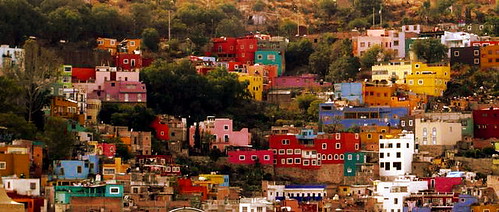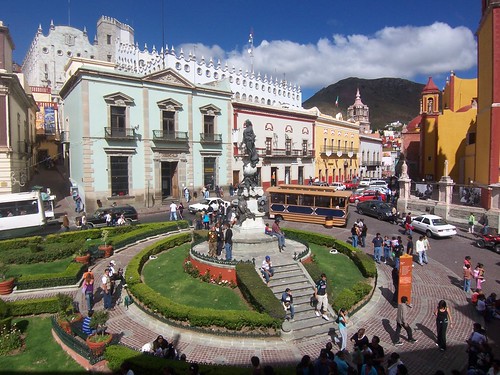--- by J.D. Roth
In 2006, my husband and I bought a house in the center of Guanajuato, a city in Mexico’s Central Highlands, where we live about one-third of the year. We didn’t buy the house because it’s a cheaper place to live; we were motivated because we’d been visiting this town for five years and fell in love with it anew every time we came. Despite the fact that we live pretty simply in the States, it’s less expensive in Guanajuato. Here are some of the ways we save.
Transport. We’re happy not to have a car in Mexico. We walk everywhere: to do errands, visit friends, go out for coffee, shop. Numerous small groceries, mom ‘n’ pop shops, bakeries, and coffee shops are located within a few minutes’ walk of our home. When I buy groceries, I only buy as much as I can carry in my backpack. If I need more, I go out again later, or the next day. Walking is always a pleasure — and even an inspiration — because the town is so colorful and lively and many areas are pedestrian-only. We live on one of Guanajuato’s many traffic-freecallejones (alleys). Buses and economical taxis are also available for longer distances.
Guanajuato is located in a valley. Wherever I am in town, I feel like I’m in a big salad bowl of houses, colonial buildings, and churches the color of fruit — mango, watermelon, lemon, kiwi. Because of the city’s topography and its steep, narrow alleys, foreigners with cars either have to live in the suburbs or park their cars in expensive garages (often located on the other side of town).
In Eureka, on California’s North Coast, where we live the rest of the year, we have a 1989 Mazda Miata, bought secondhand, and an even older camper van. In town, we walk or bicycle as much as possible, but even without driving everyday, owning two vehicles is still expensive. It’s also more of an effort to walk in Eureka, because there’s nowhere near as much life and joy on the street.
Food. We eat a bit less in Mexico, because it’s warmer, and because we’ve adopted the local style of having our comida (the single main meal) around 2:00 p.m. Vegetables, fruit, beans, and rice, which make up a lot of our diet, are plentiful and inexpensive. We have three gas burners, a toaster-oven, and a microwave. Ovens are rare in Mexico. One downside of cooking is that we have to disinfect all vegetables in a weak solution of iodine before cooking, which takes about ten minutes.
Fitness. In Eureka, I pay to belong to a gym. One great advantage of Guanajuato is that the topography and elevation (almost 7000 feet) conspire to keep us fit. Between walking around town, climbing the hills surrounding the city two or three times a week (all of which are accessible by foot from our house), and doing bodyweight/kettlebell exercises at home, I stay in shape almost effortlessly. We brought our older bicycles down, and we cycle recreationally on Sundays, but due to the tangle of steps, ramps, alleys, steep inclines, unexpected drop-offs and other obstacles in Guanajuato, we don’t use the bikes for practical errands the way we do in California.
Purchases. We tend to spend less on purchases in Mexico than in the U.S. For instance, I buy fewer clothes and books. I satisfy my English-language reading needs mainly online. I buy Mexican newspapers and magazines from time to time.
Heating. We don’t pay for heat in Guanajuato, whereas it’s a big expense in Eureka. In winter, Guanajuato can be cool in the early mornings and evenings, but we just layer up and dress warmly, whereas in damp, chilly Eureka, we can’t get by in winter (or even in other seasons of the year at times!) with just an extra sweater.
House taxes. Part of our rent in California goes toward our landlord paying house taxes, whereas in Guanajuato, we only pay about $50 tax annually.
Services. We spent three years remodeling our Mexico house, using the services of a real-estate attorney, architect, carpenters, electricians, metal workers, and painters. We completed the remodel about two years ago, but maintenance is an ongoing issue in our old adobe house. Last fall, our maintenance man, Juan, spent the best part of a day digging up and replacing part of our sewage pipe, which had gotten clogged. He charged $45 for a messy, difficult job, although we were more than happy to add a substantial tip. Ernesto, a metal worker, recently built and installed two new window frames for the bargain price of $100. We pay more for services than products in Mexico, but they’re rarely costly.
Daily life. In Mexico, my life is focused more on the basics: disinfecting vegetables, cooking, hanging clothes on the line, sweeping, walking. When U.S. friends ask me how I spend time in Mexico, I say, “Life itself takes more time.” I don’t resent it. Focusing on simple, concrete activities is deeply satisfying. In Eureka, on the other hand, I’m very work-focused. I love my work, which istraining and coaching managers and leaders, but it does feel more mental and abstract than do my activities in Mexico.
Entertainment. The University of Guanajuato has a professional orchestra that offers weekly symphonies at a cost of about $5, held at a concert hall five minutes from our home. Many national and international concerts and performances are offered year-round, rarely for more than about $8. Popular movies cost $3, and a city film club offers international artsy films with sub-titles at similar prices.
Travel. When we explore other parts of Mexico, we travel in comfortable and reasonably-priced buses, and stay at hotels that rarely cost more than $35 a night.
Not everything in Mexico is cheaper, of course. Furnishing our home cost more than it ever did in the U.S. because secondhand furniture is much less common in Mexico. Mexicans don’t upgrade or get rid of stuff as often as Americans, and when they do, they usually pass on their old item to another family member. We couldn’t find desks for sale, new or used, so we hired a local carpenter to build desks and a dining room table.
Another expense in Mexico is Spanish classes, a cost we don’t have in the U.S. But at the price of $10 an hour (or less) for a private tutor, it’s not going to break the bank, and is well worth it, not only because our teachers help us improve our Spanish, but because they become our friends.
Saving money is a fringe benefit of living in Mexico, but as I said, it wasn’t what motivated us to buy our house. While it’s true our day-to-day costs are less than in California, there are so many other attractions of life in Mexico that delight us. The sense of vitality and energy on the streets, the beauty of the city, the thrill of mastering another language, the pleasure in making Mexican friends, the challenge of understanding a culture so radically different from our own…the list goes on and on. Every time I re-enter the city after a time away, I see the high rock walls again and the colors of houses, and I shiver with anticipation.
At this point, we’re not ready to move full-time to Mexico mainly because of my work in California. Meanwhile, we appreciate the contrast between our Mexican and U.S. lives: sea level vs. highlands; overcast vs. sunshine; English vs. Spanish; kayaking the bay vs. hiking the hills…we’re graced with the best of both worlds.





No comments:
Post a Comment